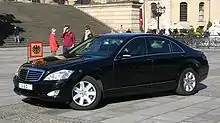Armored car (VIP)
A VIP armored car is a civilian vehicle with a reinforced structure that is designed to protect its occupants from assaults, bullets and blasts. Armored cars are typically manufactured with bulletproof glass and layers of armor plating, often with a variety of other defensive mechanisms and features to aid the individuals inside. Unlike military armored vehicles, a civilian armored car is designed to be inconspicuous and similar to its factory version.


Armored cars are used internationally and often used to protect high-profile individuals such as heads of state, political figures, businesspersons, VIPs, and sometimes celebrities. They may also be used by governmental law enforcement agencies as well as private military contractors. Chicago mobster Al Capone reportedly owned an armored 1928 Cadillac 341A.[1][2]
Base vehicles
Most civilian armored cars are created by fitting aftermarket upgrades to standard production cars.[3] Several car manufacturers produce armored car models from the factory, such as the Audi Security Vehicles (A6 and A8 models), Lincoln Town Car BPS, Hyundai Equus, BMW Security series (3 Series, 5 Series, 7 Series and X5 models), the Mercedes Benz Guard vehicles (E, ML, GL, G & S Class).
Some civilian armored cars may be one-off unique vehicles with no standard equivalent, such as the current Presidential state car of the USA which is built on a medium-duty truck platform styled like a Cadillac.

Certification
There are a variety of armoring standards[4][5] which relate to non-military armored vehicles, the most common are:
- Ballistics Rating (BR): This is a European standard which certifies the materials used both transparent (BR - DIN EN 1063) and opaque (FB - DIN EN 1522/23), general guidelines on vehicle construction and covers 3 levels from 2 to 7 . This is usually grouped under a single definition of B, e.g. B6
- Vereinigung der Prüfstellen für angriffshemmende Materialien und Konstruktionen (VPAM)[6] - VPAM have a number of standards that relate to non-military armored vehicles, they are:
- APR 2006 - These are the general test guidelines for armored products.
- PM 2007 - This covers the materials used.
- BRV 1999 and 2009 - This certification indicates that the whole vehicle has been tested instead of just the materials used.
- ERV 2010 - Blast protection certification.
- Vehicle Security Advisory Group (VASG) - A British Standard for armored car construction and testing.
- National Institute for Justice (NIJ) - The American National Institute of Justice certification, covers body armor as well as vehicles and covers 5 levels.
See also
References
- Bell, Kirik (January 24, 2020). "Untouchable: 1928 Cadillac armored car likely owned by Al Capone for sale". Motor Authority. Retrieved April 16, 2021.
- "Rental Presidential limousine". Thursday, 24 November 2022
- "Armored Toyota Land Cruiser - Upgrades".
- "Armouring Standards - Freedom EU: Armoured Car Sales & Armoured Car Hire". Archived from the original on April 6, 2018. Retrieved December 18, 2017.
- "Summary Ballistic Standards".
- "Die Vereinigung der Prüfstellen für angriffshemmende Materialien und Konstruktionen". VPAM (in German).
